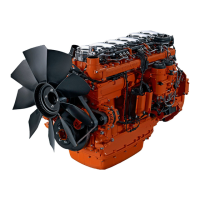
Do you have a question about the Scania DC12 and is the answer not in the manual?
| Configuration | Inline 6-cylinder |
|---|---|
| Bore x Stroke | 127 mm x 154 mm |
| Cooling System | Liquid-cooled |
| Engine Type | Diesel |
| Displacement | 11.7 liters |
| Weight | Approx. 1100 kg |
Details warranty for emission control systems.
Specifies the duration of the warranty coverage.
Lists components included in the emission warranty.
Outlines general restrictions and responsibilities for warranty.
Lists specific conditions not covered by the warranty.
Contact information for warranty assistance.
Covers general safety principles and warnings for engine operation.
Essential safety measures before and during engine operation.
Guidelines for safe handling of fuels, oils, and chemicals.
Safety procedures for engine maintenance and servicing.
Procedure to retrieve fault codes from the EMS control unit.
Steps to erase passive fault codes from the EMS control unit.
Procedure to retrieve fault codes from the EMS coordinator.
Steps to erase passive fault codes from the EMS coordinator.
Initial maintenance steps before the first engine start.
Details on coolant types and recommended mixtures for protection.
Describes engine speed ranges and their implications.
Defines different maintenance schedules based on operating hours.
Specific maintenance for engines with low usage.
Specifies engine oil classifications and viscosity requirements.
Details on oil analysis for determining change intervals.
Instructions for cleaning the engine radiator fins.
Procedure for cleaning the charge air cooler on DI engines.
Steps to remove oil and grease from the cooling system.
Procedure for removing deposits from the cooling system.
How to read the vacuum indicator for air cleaner status.
Maintenance procedure for the coarse cleaner component.
Instructions for servicing the air cleaner filter element.
Daily check procedure for the fuel level.
Procedure for replacing the main fuel filter and water separator.
Procedure for checking battery electrolyte levels.
Method for checking battery charge status using an acid tester.
Steps for cleaning batteries, cables, and terminals.
Inspection of drive belt condition and tensioner.
Specifications for coolant used during engine storage.
Instructions for using preservative fuel for engine storage.
